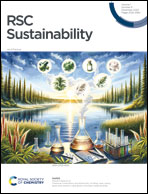Direct re-lithiation strategy for spent lithium iron phosphate battery in Li-based eutectic using organic reducing agents†
Abstract
One of the most commonly used battery cathode types is lithium iron phosphate (LiFePO4) but this is rarely recycled due to its comparatively low value compared with the cost of processing. It is, however, essential to ensure resource reuse, particularly given the projected size of the lithium-ion battery (LIB) market. A simple, green, inexpensive, closed-loop process is proposed for recycling LiFePO4 cathodes, via delamination of the cathode active material from the aluminium current collector by simple immersion in water. Two regeneration routes are compared to demonstrate how recovered Li1−xFePO4 can be regenerated: (1) direct re-lithiation of the spent cathode material under ambient temperature and pressure using a eutectic system made from lithium acetate and ethylene glycol with hydroquinone as a reducing agent, and (2) oxidative leaching of lithium ions in water, with iron(III) chloride as an oxidising agent, followed by regeneration back to the LiFePO4 olivine structure using same re-lithiation method. The use of this non-aqueous lithium-based eutectic system in combination with a reducing agent decreases the temperature and number of steps required for the regeneration of LiFePO4 and restores the electrochemical performance of the spent material.



 Please wait while we load your content...
Please wait while we load your content...